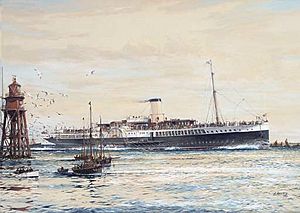Mucking facts for kids
Mucking is a small village, also known as a hamlet, located in southern Essex, England. It sits right next to the Thames Estuary. Mucking is about 2 miles (3.2 km) south of Stanford-le-Hope and is now part of the Thurrock area.
Contents
Mucking's Ancient Past
Mucking was once a very large Anglo-Saxon settlement. It might have had over 100 people living there. This place was very important because of its location near the River Thames. It was likely a meeting spot and a market for people from both sides of the river.
The name "Mucking" comes from an old language called Old English. This shows that people have lived here for more than a thousand years! The name probably means 'the family or followers of Mucca'. Mucca was likely a local leader. Some people think it could also mean 'Mucca's place' or 'Mucca's stream'.
Because Mucking is on flat marshland near the mouth of the River Thames, early settlers from Europe probably arrived here quite early. In fact, people found the outline of another old Saxon village, West Mucking, from photos taken from the air.
Mucking also had a small industry that made iron. They used iron ore found in the area. They made spongy iron blocks and cleaned them using a process called 'Mucking'. We don't know if this process is connected to the village's name or if it's just a coincidence!
Mucking in Modern Times
Even though Mucking is a small village today, it was quite busy during the Victorian era. It had small shops and a large house for the local church leader. It also had a medieval church called St John the Baptist. Both the old church and the large house are now private homes. You can only visit the church's graveyard if you get permission first.
The village also gave its name to Mucking Flats. This is a large area of mudflats on the estuary to the east of the village. It's a special place for nature, known as a Site of Special Scientific Interest. There was once a small lighthouse here too.
In 1936, Mucking became part of the larger Thurrock area.
Digging Up History: Archaeology at Mucking
Mucking became famous for a huge archaeological dig. This happened before a gravel quarry dug up the land.
People found the site in 1959 by looking at crop marks in the soil from aerial photos. These marks show where old buildings used to be. The dig was led by Margaret Jones and lasted for many years, from 1965 to 1978.
Archaeologists found many important things from the Saxon period. They also found items from the Stone Age all the way up to the medieval period.
The Saxon settlement found at Mucking was very big. It had more than 230 buildings! The site also had two cemeteries. Many of the buildings were "sunken huts," which were partly dug into the ground. There were also larger timber halls, which might have been for more important families. Over about 200 years, the settlement slowly moved north after it was first built in the 4th century.
The Old Parish Church
The old church in Mucking was named after St John the Baptist. Most of it was taken down and rebuilt in the mid-1800s. Now, it's no longer used as a church and has been turned into a private house.



